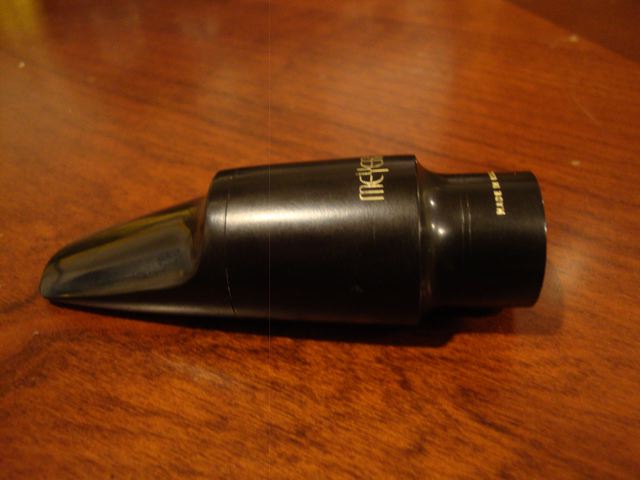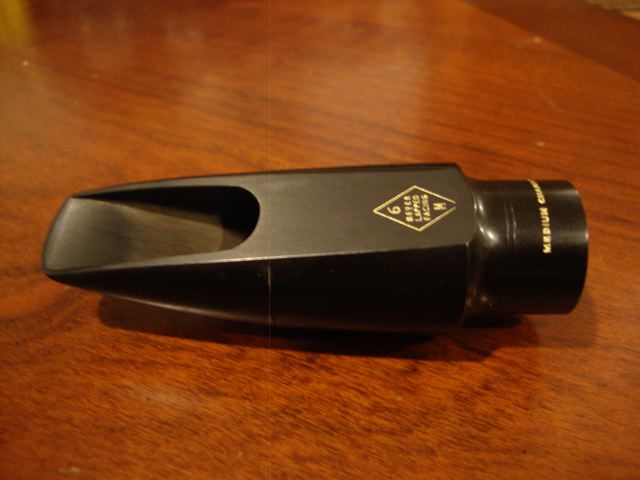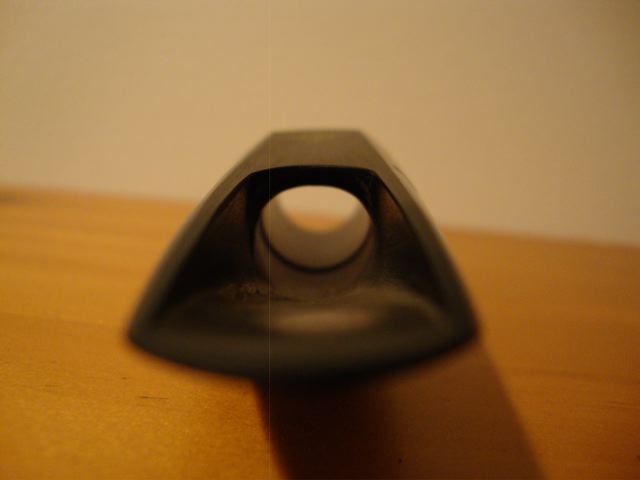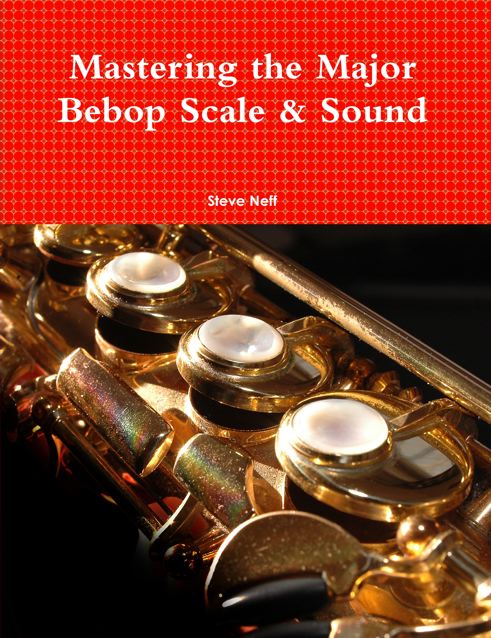This is a new Meyer medium chamber alto saxophone mouthpiece that is made by JJ Babbitt. If you have been an alto saxophone player for any length of time you will know the mouthpiece name “Meyer”. It is one of the most popular alto saxophone mouthpieces ever sold. When I was a kid, i remember going to the music store to get a Meyer because that was what all the best alto players were using. I had heard that Phil Woods played on one and then I went to a Jazz Festival and a group called the YellowJackets played. They had one of the best alto sax players I had ever heard. His name was Marc Russo and his altissimo playing was amazing. I remember wondering what mouthpiece he played and someone told me…………..a Meyer. That same year I went to a summer band camp and the sax teacher was this college kid from Eastman that sounded amazing. What did he play? A Meyer. That did it for me, I had to get a Meyer. Anyways, back to the music store. I remember trying probably 10 different Meyer mouthpieces at that store and I hated everyone of them. Some were stuffy, some I squeaked on, some were too bright sounding, some I couldn’t get a any volume out of. I remember leaving that store totally bummed out ( I ended up getting a Beechler soon after that and played that all through college)……………..
Phil Engleman Refaced Meyer 6
I never did run across a great Meyer alto mouthpiece but I’ve known tons of players through the years who have played them and sounded killer on them. Recently, Phil Engleman a mouthpiece refacer advertised that he was selling some stock Meyer that he would work on to make sure they played great. I took him up on his offer and bought a 6 & 7 from him.
The day I received the mouthpieces in the mail I was heading off to teach so I just put them in my bag. One of my first students plays a Meyer 5 that he has been having issues with so I had him try the Meyer 6 that I had just received from Phil. I have to say that the difference in sound was immediate. I was thinking “Wow” in my head when the student stopped playing and looked at the piece and said “Wow” also. His sound was fuller and rounder sounding. Nice and smooth sounding. His old Meyer was always sounding raspy and spitty sounding and this new piece sounded 100% better. He wanted to buy it right there but you have to remember that I hadn’t even played the mouthpiece yet so I said “No” and gave him Phil’s email address to get his mouthpiece worked on during the summer.
This clip is of the Meyer 6 from this story. It’s an easy mouthpiece to play with a brand new Vandoren Java 3 reed. I find the tone to be on the brighter side of the spectrum. The high end is a bright but still round sounding. The tone is incredibly easy to manipulate and shape. It reminds me a bit of my Aizen mouthpiece in the resistance it has. It feels easy to blow but it feels like you are blowing against something solid that makes the tone have a nice character to it. Also of note, is that I find the altissimo very easy to play on this mouthpiece. Much easier than some others I have played. The altissimo notes have a sweet sound to them that is beautiful sounding. I’m really diggin’ this piece for the time being and think I will hang on to it for awhile to see where it takes me.
Phil Engleman Refaced Meyer 6
- Appearance:
The tip and rails of this mouthpiece are perfect. The chamber is nice, smooth and looks to be very symmetrical and balanced. When looking into the chamber from the table you can see a slight ridge where the chamber meets the bore but that doesn’t make any difference to the playablity of a mouthpiece.
- Tone:
Beautiful balanced tone. A little bit on the brighter side with a Phil Woods kind of vibe to it. Easy to sub-tone down low. The notes have a nice focus to them but still have a nice round sound to them. The high notes have a pleasant singing type quality to them that I loved.
- Intonation:
As perfect as it gets. I played it with a tuner and couldn’t ask for better.
- Control:
To be honest, this was one of the highlights of this mouthpiece. It was amazingly easy to play. It had an even and smooth tone throughout the range that made it easy to play fast patterns and large intervals. Altissimo and the overtone series were very easy on this mouthpiece. Much easier than most of the mouthpieces I have played. Maybe it’s because of the smaller tip.
- Volume:
Although I could get pretty loud, it wasn’t as loud as many other mouthpieces I have tried. I found that if I pushed the ligature back and took more mouthpiece to let the reed vibrate more it really improved the volume. I think it will get better as I get more comfortable on the smaller tip opening. (I mostly play .080 tip openings on alto.






Hey Steve…just wanted to say you sound great…i was also wondering if Phil was still selling some of his Meyers…thanks
Steve…can you share Phil’s email please?
Thanks
Hi steve can you put me in touch with phil engleman I am trying to find a very nice playing meyer alto mouthpiece 6m Thanks David
phil-tone@hotmail.com is his email.
Steve, can you put me in touch with Phil Engleman ,also. I have a Meyer #6&7m.How much does he charge to fix my mothpieces and how much for his? I like a bright sound and have never been happy with my sound on the Alto. I have a super- balanced action Selmer( I think). I also have a.Bechler S7S and a Claude Lakey 5*3 mouthpiece.I use a medium/soft Lavoz reed, or a rico 2 or 2 1/2 or aVandoren# 2 reed .I also read that Fred Lipsius(Blood Sweat&Tears), also uses a 5 Meyer and sounds great. I also love Sanborn’s sound. Please advise all around .
Thanks so much. Ron.
Phils email is phil-tone@hotmail.com. I’m not sure how much he charges now. Contact him and see what he says…….Good Luck. He does great work!
Very good mpc for less than 200 $!
How does this compare to an ishimori woodstone hr???
The Ishimori alto piece is one of my all time favorite pieces. It just has a huge tone to it. Phil’s Meyers are very good also but for me the Ishimori is perfect…………
Hello Steve,
What about the Meyer 7 you bought with the 6? Did it sound good? I’m going to buy a Phil Tone Meyer but I’m not sure yet of the opening : 6 or 7….maybe both?!
Thanks
They were both good but I preferred the 6 for me. It had a more centered core sound which I liked a lot. If you have to play in louder situations you might want to go for the 7 because you can push more air through it.
After trying several of the newer custom made hand crafted mouthpieces, I’m going back to a Meyer. Recently I’ve been playing on the Drake NY Jazz 6. These newer mouthpieces seem to be bright and easy to play, but I find they sound a bit thin and lack that warm rich center tone (like I hear in this Meyer you’re playing). I recently had Ed Pillinger make me a replica of a 1950’s era NY Meyer 6 opened up to .080. I’m still getting used to it, but it has a wonderful rich sound. I think you sound great on this Meyer.
Thanks Erik,
Meyer’s have such a history and tradition for a reason. Nothing better than a great one!
And how i can purchase it? Can you send me the Phil Engleman email adress?
Thanks.
Bernardo, I sent it to you through email. Steve
I have a meyer 6m and I find difficulties on reaching the high register, I have to make too much effort.I use vandoren 2 1/2 reeds
Santi, You could always send it to a refacer just to have it checked out. Many of them will check it out and let you know what if anything is wrong with it. Then you have to decide if you want them to fix it. Steve
Hi Steve. I noticed you also reviewed Meyer G with Brian Powell opening the tip to 6 so considering both Phil and Brian are great refacers and you use the same tip on both regular Meyer and Meyer G reviews, I thought it would be nice to compare the sounds. To me Meyer G sounds smoother and warmer. I was wondering if you could make any comment on comparing these two. I know it’s the matter of the past and it’s hard to even remember the qualities and differences but I thought I check see if you could give any impression left for you for these mouthpieces. I bought a regular Meyer 5MM and I thought at some point send it to reface but I just bought it so I could exchange it for a Meyer G instead and put it in the cue for refacing. I did a lot of google search and couldn’t find any source that put the differences into variables (throat & chamber size, overall length, facing curve, etc.) the same way that Ralph Morgan compared the 30s vs. 60s Meyer. Even all these great copy makers don’t spell out their own product measurements and compare it with the 30s Meyer. I don’t know why. Not that it’s the only important thing. I think a lot of energy is being absorbed by the rubber / resin material and this energy absorption varies for different frequencies which means if the old rubber of 30s is not used, using the exact same dimensions is not going to result the same tone for each note anyway. I found out that most of the Meyer copies sound thin in the upper registers because of lack of enough low-mid frequencies. Some in order to address this thin highs try to reduce the high frequency of reed resonation by dampening the reed vibration through lengthening the facing curve but then the mouthpiece response is impacted. I am trying to see which of all these Meyer inspired designs give a more balanced sound (sounding warm throughout the whole range), but lively and singing, and with great response. Thanks.
Arya,
Sorry, it’s been too long for me to compare these two mouthpieces. I don’t remember enough about them to be able to do it. I would have to listen to the clips and compare that way but that is what you can do also so not sure how much help it would be. I really like the Ishimori Woodstone HR alto mouthpiece I reviewed here on the site for that Vintage Meyer type of sound also.